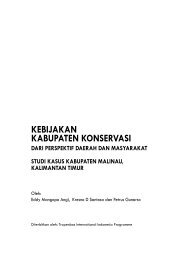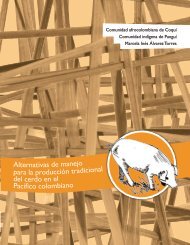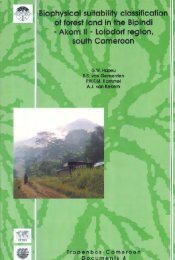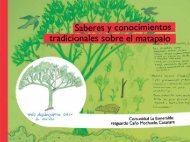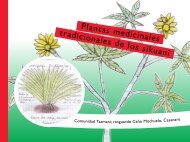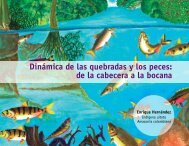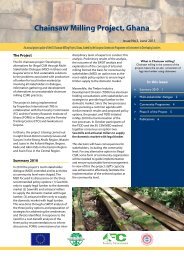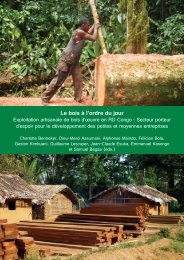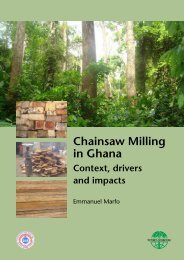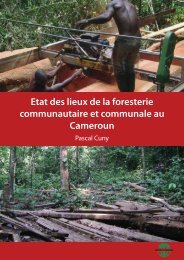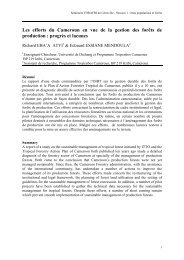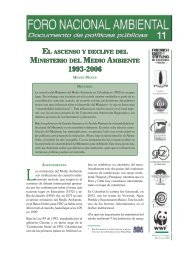Download the publication - Tropenbos International
Download the publication - Tropenbos International
Download the publication - Tropenbos International
Create successful ePaper yourself
Turn your PDF publications into a flip-book with our unique Google optimized e-Paper software.
Plant diversity in a Central African rain forest: Implications for biodiversity conservation in Cameroon<br />
should be carried out with <strong>the</strong> local communities in <strong>the</strong>ir villages and in logging<br />
concessions in order:<br />
122<br />
To prepare a checklist of all timber and NTFP species used by <strong>the</strong> local<br />
people;<br />
To carry out a market survey to assess <strong>the</strong> demand and trade of <strong>the</strong>se<br />
products;<br />
To study <strong>the</strong>ir biomass, densities, dynamics and <strong>the</strong> impact of <strong>the</strong>ir<br />
exploitation on <strong>the</strong> forest ecosystem.<br />
Ecological monitoring<br />
Tropical rain forests are fragile because of <strong>the</strong>ir complex dynamic ecosystems, <strong>the</strong>ir<br />
high number of species and <strong>the</strong>ir rich interacting structure. Although <strong>the</strong>y are well<br />
adapted to persist in <strong>the</strong> environment in which <strong>the</strong>y have evolved, <strong>the</strong>y are much less<br />
resistant to human disturbances. Therefore, in <strong>the</strong> Campo-Ma’an area, it is of vital<br />
importance to monitor human activities and related changes in flora and fauna. This<br />
will enable <strong>the</strong> park management to act appropriately whenever undesired changes<br />
in <strong>the</strong> conservation status of its rich biodiversity occur. Remote sensing images and<br />
impact studies on human activities are required to monitor land cover changes, and<br />
<strong>the</strong> changes in vegetation, flora and fauna within and around <strong>the</strong> park.<br />
This study has demonstrated that <strong>the</strong> Campo-Ma’an area harbours about 141 plant<br />
species of high conservation priority and 92 threatened species listed in <strong>the</strong> red data<br />
list of IUCN (2002) and WCMC (1998). Of <strong>the</strong> 29 strict endemic species that only<br />
occur in <strong>the</strong> Campo-Ma’an area, 17 are <strong>the</strong> most threatened since <strong>the</strong>y are located<br />
outside <strong>the</strong> National Park and in areas such as <strong>the</strong> coastal zone, and at <strong>the</strong> vicinity of<br />
settlements and large agro-industrial plantations where human pressures are severe.<br />
Fur<strong>the</strong>rmore, <strong>the</strong>ir habitats are fragmented and degraded as a result of past and<br />
present land conversion to subsistence agriculture and industrial plantations.<br />
Research is urgently needed on <strong>the</strong> population biology and ecology of <strong>the</strong>se<br />
threatened species. In order to avoid <strong>the</strong> extinction of <strong>the</strong>se species, botanical<br />
monitoring should be carried out to assess <strong>the</strong>ir status. Measures to secure <strong>the</strong>ir<br />
conservation should include <strong>the</strong> strict protection of <strong>the</strong>se fragmented type localities.<br />
Ecological sustainable agriculture<br />
Shifting agriculture is identified as among <strong>the</strong> most destructive uses of <strong>the</strong> forest<br />
since it involves large amount of land conversion from natural forest to farms and<br />
fallow. In order to prevent fur<strong>the</strong>r encroachment into <strong>the</strong> remaining lowland and<br />
coastal forests, farmers need to intensify <strong>the</strong>ir agricultural production systems.<br />
Fur<strong>the</strong>rmore, crop production needs to be increased in <strong>the</strong> existing agricultural lands<br />
to feed a growing population. Farmers should be encouraged to form common<br />
initiative groups in which <strong>the</strong>y can receive adequate training on nursing, planting,<br />
maintenance, harvesting, storage and marketing techniques from <strong>the</strong> local staff of<br />
<strong>the</strong> Ministry of Agriculture.<br />
Conservation and environmental education<br />
Biodiversity conservation is a concept that is not yet well understood by <strong>the</strong> local<br />
communities. As a result <strong>the</strong>re is a permanent conflict between conservation<br />
initiatives and <strong>the</strong> needs of <strong>the</strong> local communities and o<strong>the</strong>r stakeholders such as



